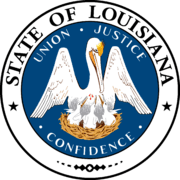George Eustis, Sr.
| George Eustis, Sr. | |
|---|---|
 | |
| Born |
20 October 1796 Boston, Massachusetts |
| Died |
23 December 1858 (aged 62) New Orleans, Louisiana |
| Resting place |
First Church in Jamaica Plain Cemetery, Jamaica Plain, Massachusetts 42°18′35″N 71°06′57″W / 42.30976°N 71.11594°W |
| Residence | New Orleans, Louisiana |
| Education | Graduated from Harvard College, 1815 |
| Occupation | First Justice of the Supreme Court of Louisiana |
| Spouse(s) | Clarisse Allain ( -1876) |
| Children |
|
| Parent(s) | Jacob Eustis & Elizabeth Saunders Gray |
| Relatives | Uncle: William Eustis, Governor of Massachusetts |
George Eustis, Sr. (October 20, 1796 – December 23, 1858) was Chief Justice of the Louisiana Supreme Court in 1838. He was also one of the founders of the Pontchartrain Railroad and a benefactor of the University of Louisiana, now Tulane University.
Biography
George Eustis was born in Boston, Massachusetts on October 20, 1796. He graduated from Harvard University in 1815 and was appointed as private secretary to his uncle, William Eustis, who was then serving as Minister to the Netherlands. Having begun studying law while in the Netherlands, Eustis settled in New Orleans, Louisiana in 1817, completed his studies, and was admitted to the bar.
A Whig, Eustis served three terms in the Louisiana House of Representatives in the 1820s. He was Louisiana Attorney General from 1830-1832. From 1832 to 1834 he was Secretary of State. As Secretary of State he helped establish Medical College of Louisiana, which received its charter in 1835.
From 1838 to 1839 Eustis was a Justice on the Louisiana Supreme Court. He was a delegate to Louisiana's 1845 constitutional convention, where he secured approval for establishment of the University of Louisiana. The University received its charter in 1847, and he was ex officio President of the original Board of Trustees.
In 1846 Eustis became Chief Justice of Louisiana Supreme Court, and he served until 1852.[1]
Chief Justice Eustis died in New Orleans on December 23, 1858. His remains were taken aboard the steamship Cahawba for the trip north so they could be interred in the family tomb in Jamaica Plain, Massachusetts, a fact noted by Richard Henry Dana, Jr. author of the celebrated Two Years Before the Mast. Dana was traveling on the same vessel, as described in his 1859 work To Cuba and Back.[2]
Sources
- The New England historical and ... - Henry Fitz-Gilbert Waters, New England Historic Genealogical Society - Google Boeken. Books.google.com. Retrieved 2011-12-27.
- The Railway world - Google Books. Books.google.com. 2004-03-10. Retrieved 2011-12-27.
References
- ↑ "Dictionary E - Louisiana Historical Association". Lahistory.org. Retrieved 2011-12-27.
- ↑ Dana, Jr., Richard Henry (1859). To Cuba and Back: A Vacation Voyage. London: Smith, Elder & Co. p. 249.
| Legal offices | ||
|---|---|---|
| Preceded by Alonzo Morphy |
Attorney General of Louisiana 1830–1833 |
Succeeded by Etienne Mazureau |
